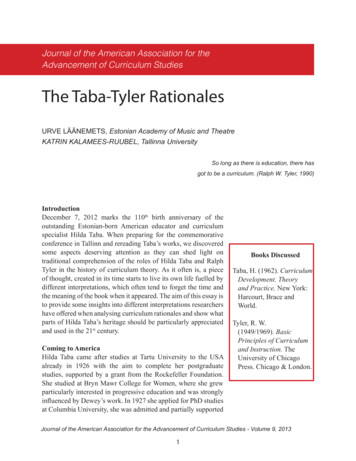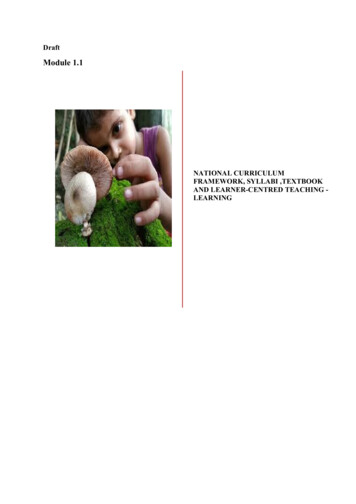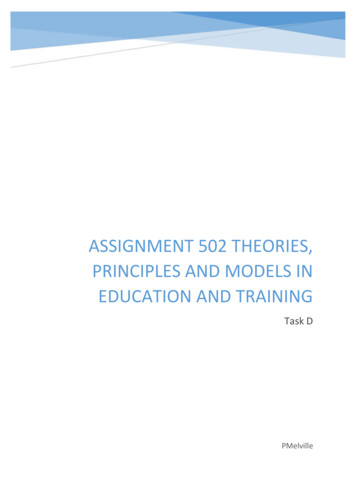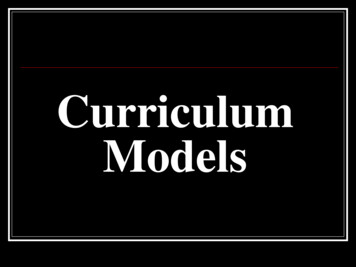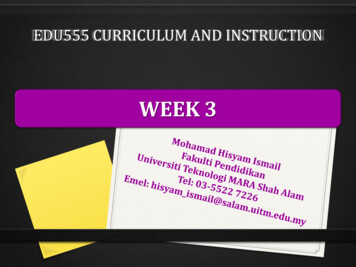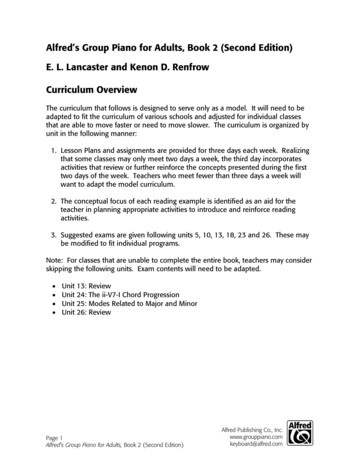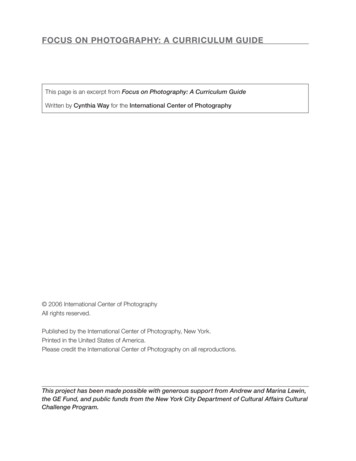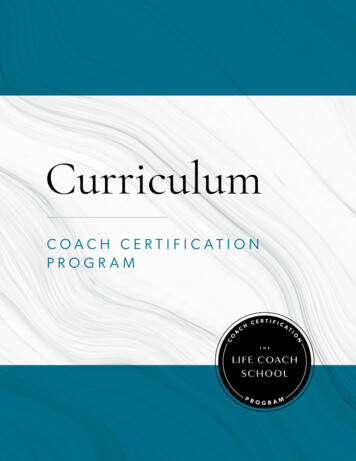
Transcription
CurriculumCOAC H C ER T I FI C AT I O NPROGRAM
CurriculumCOAC H C E R T I F I C AT I O NPROGRAM
CONTENTSHow to Coach Yourself 5Emotional Childhood 131 139 149Holding The Space 15The ManualStory vs. Fact 23Boundaries31Unconditional Love 157 39Lovability 165 43Relationships 45Outcome & Goal Cultivation 171 49Past & Future Focus 181 53How to Get It Done 189 67Money 197 73Self Confidence79Elevator TechniqueThoughts: The Cause The Power of QuestionsCoaching TipsModel TipsThe 45 Minute SessionFeelingsHow to Process PainStop BufferingStop Overeating Stop Overdrinking 103 Glossary167205 213 217COACH CERTIFICATION PROGRAM CURRICULUM 3
COACH CERTIFICATION PROGRAM CURRICULUM 4
HOW TO COACH YOURSELFAt The Life Coach School, we train exceptional coaches, and it all starts with learninghow to coach yourself. That’s right, you are your first client. Mastering the SelfCoaching Model by using it on yourself is not only good practice; it’s absolutelynecessary to help your clients achieve life-changing results.Learning how to coach yourself will open the door to possibilitiesyou didn’t even know existed.You’ll discover how your thinking is creating everything in your life and why that is thebest news ever. Mastering the skill of self coaching is the best gift you can give yourselfand your clients. Are you ready? Let’s do it!COACH CERTIFICATION PROGRAM CURRICULUM 5
THE MODELThe coaching philosophy you’ll learn in this program is called “causal coaching.”Life coaching isn’t about treating the symptoms of pain or shortcomings—it’s aboutfinding the root cause of each symptom, understanding it, and then helping clientschange it to make room for new seeds of success and fulfillment. This is where theModel comes in.Brooke Castillo created the Model as a daily tool that she herself could use toimplement all the great things she had learned from forward thinkers such asByron Katie, Eckhart Tolle, and Abraham. All of our certified coaches use the Modelnot only to coach themselves but also to get to the root of their clients’ issues.Every issue we encounter in our lives can be broken down into five interrelatedcomponents, with changes in one component affecting the others.Understanding how this works gives you, as the coach, greater insight.No matter what issue your client brings to you, you canpinpoint the cause and begin coaching there.When you understand each of these components, you can clearly identify theproblem your client is experiencing and decide which category it fits into. Then youcan use your coaching inquiry skills to uncover the root cause of the problem andbuild a picture of what’s going on in each of the other components.COACH CERTIFICATION PROGRAM CURRICULUM 6
This is because our thoughts about our circumstances cause our feelings, which inturn cause our actions, and ultimately create results in our lives. For example, yourclient might be concerned about overspending. This fits into the action componentof the Model. Then you’ll know you need to uncover the thought and feeling causingthe action. The thought “I’m not pretty enough, and a new dress will help me feelprettier” leads to a feeling (sad) that leads to an action (overspending) that leads toa result. Let’s break down each component and continue to explore examples.The five components of the Model are: Circumstances Thoughts Feelings Actions ResultsCOACH CERTIFICATION PROGRAM CURRICULUM 7
C I R C U M S TA N C E SCircumstances are things outside our control. These include other people, our past,and the weather. Sometimes we forget that we can’t control these things, so weexpend energy trying to control other people or change our past. As frustrating asthis can be, there is good news. While we can’t control our circumstances, we cancontrol everything else, including what we decide to think and how we feel and behave.Circumstances can be proven in a court of law and are facts that everyone would agreeupon at any given time. As your clients describe a problem or situation to you, they willinclude very few circumstances, but they may not realize this. They may think they’rejust relaying the facts, but in reality, they’re their thoughts instead.For example, perhaps your client is struggling with juggling motherhood every day.As she tells you about it, she might say, “Well, I just don’t have time for things I wantto do because I have to take care of my kids.” This feels like a fact or a circumstanceto her, but it’s actually her thought about the circumstance. She does not, in fact,have to take care of her kids—many people don’t. In addition, “I don’t have time”is only her perception.We all have the same amount of time and can do with it as we choose, but there willnever be more or less time. When you point this out to her, she may resist the ideathat these are only thoughts because they feel like circumstances and she’s had thesethoughts for a long time. The only actual circumstance we’ve identified is that the clienthas children. Pointing out this difference to your clients and noticing it for yourself isvery empowering and can change everything.COACH CERTIFICATION PROGRAM CURRICULUM 8
THOUGHTSAs humans, we give meaning to our circumstances through our thoughts, which arethe sentences that constantly run through our minds. Sometimes we’re aware of ourthoughts, but often we aren’t. Examples include, “I’m not good enough” or “My bossdoesn’t appreciate my work.” We can’t change our circumstances, but we can changeour thoughts about them.The root cause of any problem is always our thinking.It’s not the circumstance, but the way we think about it. It’s not our feelings, but ratherthe thought that created the feeling. It’s not our behavior, but our thoughts and feelingsthat resulted in the action or behavior. Our thoughts directly create the results weexperience in our lives. Therefore, the cause of our problem is not the unwanted results,but the thoughts that led to those unwanted results. The client’s current thinking iswhat creates their current life, so we begin there.Differentiating thoughts from circumstances will be an important first step for you inself coaching and in coaching your clients. Remember that circumstances are court oflaw factual, while thoughts are subjective, may change from person to person, and arenot true all the time. For example, “It’s 85 degrees outside” is a circumstance, while “It’shot outside” is a thought because some people might not agree that 85 degrees is hot.COACH CERTIFICATION PROGRAM CURRICULUM 9
FEELINGSFeelings are the emotions or vibrations we experience in our bodies, and they’redirectly related to the thoughts we’re thinking. Examples include anger, sadness,and excitement. Don’t confuse feelings with physical, involuntary sensations suchas hunger, cold, reflexes, and physical pain. Emotions are voluntary because we canchange what we feel by changing our thoughts.We often think that our feelings come from our circumstances. We say things like,“My husband didn’t take out the trash (circumstance), so I’m very angry (feeling).”Or we say, “My best friend is in town (circumstance), so I’m very excited (feeling).”But the truth is, our feelings come from our thoughts. Because we have over fortythousand thoughts a day, we’re not consciously aware of them all, but they are thereasons for every feeling we have. When your husband forgets to take out the trash,you have thoughts such as, “Now, I have to do it, and I don’t want to! He never pulls hisweight around here!” These thoughts are what give you feelings of anger, not thecircumstance itself.ACTIONSActions refer to behavior, reaction, or inaction, and they’re directly related to ourfeelings. Examples include eating when we’re not hungry because we’re feeling lonely,avoiding interaction with the boss because we’re feeling anger, and withdrawing fromrelationships because we’re feeling sad. If we want different actions, we can choosedifferent feelings.C O A C H C E R T I F I C A T I O N P R O G R A M C U R R I C U L U M 10
Sometimes actions are subtle, such as a change in the tone of your voice. Or itmight be inaction, such as avoiding certain people or situations. Many of us thinkwe’re able to hide our true feelings when necessary and choose how we act despitethem. Sometimes we do, but in the end, our most effective actions come from positivefeelings. When our actions are inauthentic, we come across differently to others.When we manage our thinking and take action from the feelings we want to have,we can change behaviors for the long term and create amazing results in our lives.R E S U LT SResults are the effects of our actions. Examples include being overweight becausewe’ve been eating when we’re not hungry and having dysfunctional workingrelationships because we’re avoiding interactions with the boss. Choosing differentactions will lead us to different results.We may think our results are circumstances that have been handed to us and thatare beyond our control. But the truth is, we are entirely responsible for our resultsbecause they come from our actions and are a result of our feelings, which come fromour thoughts. This is great news, because thoughts are within our control. If you canexamine your mind and help your clients do the same, you can gain the skill of choosingthoughts that empower you to create the results you truly want.C O A C H C E R T I F I C A T I O N P R O G R A M C U R R I C U L U M 11
P R A C T I C A L A P P L I C AT I O NClaire is a client who says she really wants to exercise, but she hasn’t been doing so.As we explore what she feels when she doesn’t exercise, she says, “Right before I decidethat I’m not going to exercise, I just feel apathetic. I feel no drive at all.” After a lot ofquestioning and exploring, we discover that Claire’s thought is that even if she doesexercise, it’s not going to matter anyway. This thought created the feeling of apathy,which drove her inaction.Typically, when clients discover something like this, they want to change it immediately.To be most effective, you’ll want to encourage them to slow down and not beatthemselves up for what’s going on. In fact, encourage them not to beat themselvesup ever again if they can help it. Instead, we want them to understand themselvesby developing curiosity and fascination about why they do this. There’s always a goodreason for choosing any thought. If we can’t be compassionate and curiouswith ourselves, we won’t reveal our truths.In Claire’s case, she had been unsuccessful at exercising. Since nothing ever worked,she would beat herself up over it and feel horrible. Even the exercise regimens sheattempted were punishing and painful, and of course, she became apathetic towardexercise altogether. Once she was able to connect with herself with compassion,she could decide whether or not she wanted to change her thinking.Circumstance: ExerciseThought: Even if I do it, it won’t make a difference.Feeling: ApatheticAction: Claire doesn’t exercise.Results: No difference is made.C O A C H C E R T I F I C A T I O N P R O G R A M C U R R I C U L U M 12
Whether coaching yourself or your clients, make sure you (and/or the clients) arealways in a place of compassion, understanding, and love, and from there, you can igniteyourself to change. You cannot beat yourself up in an attempt to change. If you attemptto do this, you will buckle under pressure.Your mind likes to be efficient, so once it has been thinking the same thoughts in thesame patterns over and over again, it requires practice and skill to change. If you’retrying to change your thought patterns, you’ll need to practice patience. Otherwise,you’re in a battle with your own mind, and when it’s you against your same old ways,you’re always going to lose.When you approach yourself with fascination and love, you can see major changes inspecific results and in your overall life by applying the Model. It can be used to solveany problem because all of our problems come from our thinking. This tool will be thefoundation of all the coaching you will do at The Life Coach School. The additionaltools you will learn all come from an understanding of the Model and how it applies invarious settings. If you live it and apply it to your own life and to your clients’, there isnothing you truly want that you can’t have.S E E WO R K S H E E T: ModelsC O A C H C E R T I F I C A T I O N P R O G R A M C U R R I C U L U M 13
A W O R D A B O U T A C C R E D I TAT I O NAt The Life Coach School, we’re frequently asked about accreditation. The life coachingindustry is not currently regulated. Period. This means there is no accrediting bodywith any authority deciding what’s important in a coach, who trains coaches, or what“life coaching” even means. There are private, for-profit organizations that have giventhe term “accreditation” to what they offer, but in the end, it’s only a symbol that aschool or coach agrees with their coaching philosophy and has paid the necessary feesto associate with their label.In reality, your clients won’t hire you because of your title, label, or name of your school.They’ll hire you because they believe you can help them solve their problem. To do thateffectively, you’ll need to do a lot of self coaching along the way and understand theSelf Coaching Model inside and out.The way we see it, effective coaches have three things in common:1. They do their own self coaching work, so that they can coach from a clean place.2. They have mastered high quality tools and skills.3. They genuinely love their clients from a place of integrity.This isn’t measured by the amount of coaching they’ve done, but rather, by the quality.The bottom line is that life coaching, our profession, comes with a tremendous amountof freedom, but that freedom comes with the responsibility to be accountable for thework we do with our clients. You won’t be able to lean on any licensed association foryour credibility, but then again, you shouldn’t need to. Let your work, your reputation,and who you are be your credibility.C O A C H C E R T I F I C A T I O N P R O G R A M C U R R I C U L U M 14
HOLDING THE SPACEDefinition: If your client has never worked with a coach before, you might explainthat the discussions they’ll have with you won’t resemble the conversations they havewith their friends, siblings, or mother. While their close friends might react to whatthey say and agree or disagree with them, you’re not going to do any of those things.At times, they might not like what you have to say. While close friends tend toempathize, a coach is there to reveal things to the client they might not be aware of.All of it comes from a place of love and a desire to teach them new skills, but it will feeldifferent from their lunchtime conversations with friends because you, as the coach,will be holding the space.Remember that coaching should not be about you as the coach and your agendaor needs. It’s about the client and what they need. The most important thing you cando for your client is “hold the space” for whatever they need to work out. What thismeans is that you create a virtual, spiritual place where they can unload their mindand, in return, receive an honest perspective.C O A C H C E R T I F I C A T I O N P R O G R A M C U R R I C U L U M 15
Other people in your clients’ lives are involved and not focused on objectivity,whereas your role is to remain neutral. As the coach, it’s your privilege to hold thespace and not react. You’re the one person who can listen to anything your client hasto say without reference to your own opinion. Your client can “act out” their negativeemotions with you and tell you their negative thoughts and secrets. You can helpby holding the unconditional space where thoughts and emotions can be examined,unraveled, and understood. Don’t underestimate the power of doing this.This alone can change your client’s life.This is the most important and often the most difficult part of your job. It requires thatyou do your own work. It requires the ability to listen to your clients and hear whatthey’re thinking. Keep in mind that whatever they’re saying is not all encompassing ofwho they are. Even how they view you and your sessions is not about you—it’s abouttheir minds.For example, Sara has a very painful story about how her sister victimized her. She sobsthrough every session. She rages against her sister. She believes she’s miserable“because of” her sister. A good coach doesn’t believe this story. Holding the spacemeans knowing this is just a painful group of thoughts she’s creating and recreating inher mind. No matter what her sister did forty years ago (Yes! Forty years ago!), it’s notharming her now. The only thing harming her now is her thinking about it. A good coachdoesn’t console her for her painful story or empathize with her self created pain.It’s important to love your clients. When you love them and hold the space, you will knowthat while empathy might be appropriate at times, it’s not helpful in a situation like Sara’s.She’s punching herself in the face. Crying with her will not remedy the problem in any way.Instead, we want to grab her hand and tell her to stop punching herself. This is how wecan truly help our clients get to the root of what’s bothering them.C O A C H C E R T I F I C A T I O N P R O G R A M C U R R I C U L U M 16
Sara’s coach explained that her sister is in no way responsible for how Sara is choosingto feel. This upset Sara because up to this point, everyone else in her life had agreedwith her victim story and consoled her when she cried. But in the end, those peoplehave not helped her.That’s why she’s here with a coach. Sara’s coach gave her the truth she needed, althoughshe didn’t like hearing it. She told her coach that her sister was mean, uncompassionate,and cold. And then she cried, and cried, and cried. She was in a pool of despair—a mireof her own creation. But her coach didn’t jump in the pool with her. She stayed outbecause she knew that only from dry ground could she help her out of that pool.When Sara’s coach asked her what she wanted to feel about her sister, she said shejust wanted to be able to love her. Her coach then explained that no matter how longshe’d hated her sister and whether or not she deserved it, she could still choose to loveher for her own sake. Sara was furious, but her coach continued to hold the space anddidn’t take any of it personally.Two weeks later, Sara sent the following email to her coach:I do love my sister. I am very pissed at you for pointing that out. But I want to tell youthat when I was crying and you weren’t consoling me, it gave me a tremendous amountof freedom to let go of the hate and cry. I knew you weren’t going to leave; you weren’tgoing to fall apart. You were going to stay strong. And for some reason, even though itmade me mad, it was stabilizing enough for me to really go into this issue. I’m still mad,but thank you.C O A C H C E R T I F I C A T I O N P R O G R A M C U R R I C U L U M 17
CLEAN THINKINGThe first step in being able to hold the space for your clients is to think “clean.”Even though you have the best of intentions, you’re going to judge your clients—in both positive and negative ways. You’re a human being, and that’s what humans do.We’re socialized to believe certain things, and we have a history that creates ourknee jerk thinking. You must be aware of this thinking, and you must clean it up beforecoaching your clients.You can “clean up” your thinking by first becoming aware of your thoughts andjudgments and then writing them down. Notice what your judgments are, and be sureto put them aside as you coach. Your opinion of how your clients should behave is notyour clients’ business, and it’s not going to benefit them.You can’t possibly know what’s best for your clients. Ever. Only they can know that.You can give them perspective, but you can’t know what’s right for them.If you have a judgment that a client shouldn’t be cheating on her husband or quittingher job, remember, this is due to your own thoughts and beliefs. You need to realizethat your judgment will only interfere with your ability to help your clients as a coach.Do your own work to clean up your thoughts and beliefs so you can truly be presentfor your clients—without judgment. Being clean means you’ve acknowledged youropinion and have set it free. You have an open mind for all possibilities; you knowthat only your clients can find their answers. Understanding why your clients aredoing what they are doing, how they are feeling, and what they genuinely want iswhat matters. I find that an attitude of fascination is the best way to observe clients.The word “fascination” gives me so much freedom to understand rather than tryingto fix or change them.If your client comes to a session complaining about her unemployed husband whodoesn’t help around the house, you might be tempted to agree with her complaints.But if you’ve cleaned up your own mind, you won’t be judging either your client orher husband. Instead, you’ll be ready to help your client pinpoint the thought thattriggers her pain. Talking about the husband’s behavior (something out of her control)will get you nowhere. Alternatively, focusing on your client’s mind will help her changeC O A C H C E R T I F I C A T I O N P R O G R A M C U R R I C U L U M 18
how she feels in the moment without having to change her husband. By having aclean mind as a coach, you can help your clients clean up their own thinking, which isultimately where all their power is.B E P R E PA R E DBeing prepared for the session will help you hold the space and will also allow you todefine your success as a coach, regardless of how your client responds to your sessions.There are three things you must do to be prepared.1. KNOW THE TOOLSIt’s important to master the tools you’ll be using in your coaching practice. Study theteachers and coaches you admire, and try their tools out on yourself. The only way youcan know if a tool works is if you have used it and felt it work on yourself. This will helpyou put together your own personal toolkit, which incorporates tools created by yourmentors mixed in with your own personal wisdom and knowledge.A thorough knowledge of your tools will allow you to focus on your clients, evaluatetheir needs, discover what they already know, and then select tools you can usetogether to help create the life they want. If nothing else, teach your clients how to bemore aware of what they think, feel, do, and create. Do they know how much moneythey spend? How much food they eat? Why they eat it?2. SELF COACHINGPreparing for sessions isn’t just about getting your papers in place and reviewing yournotes from the last session. It’s about being in place to hold the space for your clientswithout being distracted by what’s going on in your own life. As coaches, this is ourresponsibility. We must do the preparatory work to be available, to be present, and tohear what clients are saying and what they aren’t saying. It’s very difficult to do this ifyou haven’t cleaned out the closet of your own mind first.Remove whatever is on your mind so you can be there for your client.C O A C H C E R T I F I C A T I O N P R O G R A M C U R R I C U L U M 19
3. PRACTICE: ON YOURSELF AND CLIENTSMany of my new coach students complain that they don’t have enough clients.They believe they need more clients in order to practice. Seriously? Your bestclient is you. If you want to practice, sit down with yourself and find out whereyou need help. What isn’t working in your life? How would you approach coachingthis issue with a client?The more you practice on yourself, the better you will be able to relate toyour clients. There aren’t really any new problems. We all struggle with thesame stuff. We don’t feel good enough. We want more money. We want tolose weight. We want better relationships. We want our lives to be meaningful.Work on yourself first, and then work on applying what you’ve learned throughself coaching to your clients. That way, when your client comes to you with theexact same issue you’ve experienced first hand, you’ll be the expert.Then, coach your clients until your brain hurts. Don’t be afraid to practice. Don’t beafraid to overdeliver. Give them more than they’ve paid for. Especially when youare first learning, coach anyone and everyone who will let you. Be willing to makemistakes—they serve as valuable teachers. Own up to your mistakes and thenmake more. Keep your energy positive, helpful, hopeful, and focused on the future.Use the tools you know and have prepared.FINAL THOUGHTSHolding the space for your clients is one of the most impactful things you will do asa coach. It will be the difference between a conversation where they’re venting to afriend and one that, instead, allows them to explore a safe space where they can trulychange how they feel about themselves and their lives.For many years, Julia was a stay-at-home mother, and her husband struggled withfinding a successful career path. Julia explained to her coach that she was forced to goback to work and continues to work full time to support her husband and two children.As Julia shared her frustration over working a job she dislikes and feeling like she’sC O A C H C E R T I F I C A T I O N P R O G R A M C U R R I C U L U M 20
missing out on time with her children, she had many different thoughts. Some of herthoughts were about being grateful for the income, while others involved resentmentfor being in this situation. Most of Julia’s friends agreed that it was necessary to goback to work and empathized with her story.Holding the space for Julia meant that her coach didn’t agree with the idea that she hadto go back to work and explained that it wasn’t actually a fact. She had (and continuesto have) a lot of choices. She could have chosen to go on welfare, leave her husband,or become dependent on family members for financial support. When Julia realized this,she opened her mind up to the possibility that she had made the choice to go backto work. This thought was so much more empowering and not only helped Julia tofeel better, but it gave her the necessary space to tap into her creative mind and reallydesign the life she wants for herself and her family. This is an example of the power ofholding the space. If you practice this skill, you can have an extreme impact on thoseyou serve in your coaching practice.SEE WORKSHEETS: Pre Work Client Preparation Pre Work SampleC O A C H C E R T I F I C A T I O N P R O G R A M C U R R I C U L U M 21
C O A C H C E R T I F I C A T I O N P R O G R A M C U R R I C U L U M 22
STORY VS. FAC TFAC T S A N D T H O U G H T SOne of the most important things you’ll ever teach your clients is that facts don’t hurt.The circumstances of our lives have no effect on us until they encounter the mindand we attach meaning to them. We aren’t sad about someone dying until our mindsregister the fact. The person’s death, which may have happened days ago, has no effecton us at all. At the same moment they die, we could be laughing because our mindsaren’t aware of what just happened.Separate out the facts from the thoughts. It’s inaccurate to say, “I was devastated whenthey died.” It’s more accurate to say, “I was devastated by what I thought about theirdeath.” Do these semantics matter? Yes. When we realize that our minds cause ourfeelings, we can be much more in control of our emotional lives. It doesn’t mean thatwe won’t choose to be sad when someone dies; we most likely will. But it does mean wecan decide not to be mad when something much less significant happens in our lives.We control our emotional lives with our thinking.If your client says, “Work stresses me out,” you can point out that it’s their thoughtsabout work that stress them out. Although they might not be able to change their jobin this very moment, they most certainly can change the way they think about their job.That will change everything.C O A C H C E R T I F I C A T I O N P R O G R A M C
The coaching philosophy you’ll learn in this program is called “causal coaching ” Life coaching isn’t about treating the symptoms of pain or shortcomings—it’s about finding the root cause of each symptom, understanding it, and then helping clients change it to make room fo



